人教版(2019)选择性必修第一册Unit 4 Body Language Workbook Listening 课件(共13张PPT,内镶嵌音频)
文档属性
| 名称 | 人教版(2019)选择性必修第一册Unit 4 Body Language Workbook Listening 课件(共13张PPT,内镶嵌音频) | 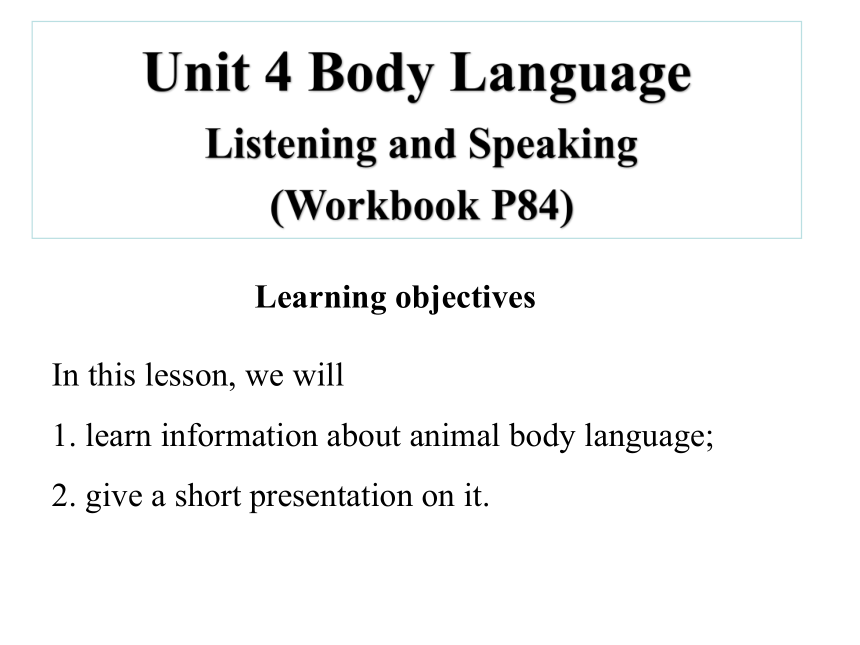 | |
| 格式 | pptx | ||
| 文件大小 | 13.3MB | ||
| 资源类型 | 教案 | ||
| 版本资源 | 人教版(2019) | ||
| 科目 | 英语 | ||
| 更新时间 | 2023-04-19 11:32:46 | ||
图片预览

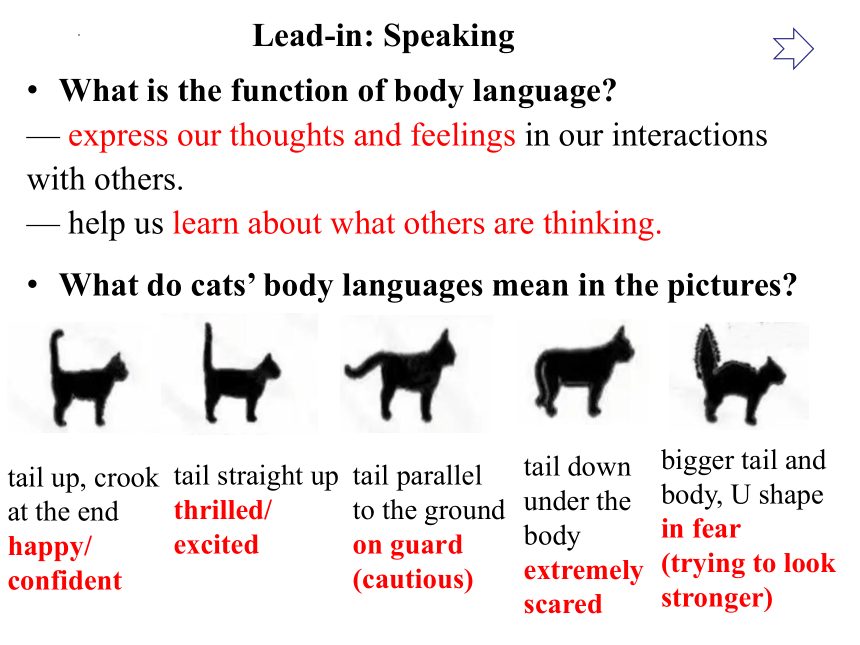
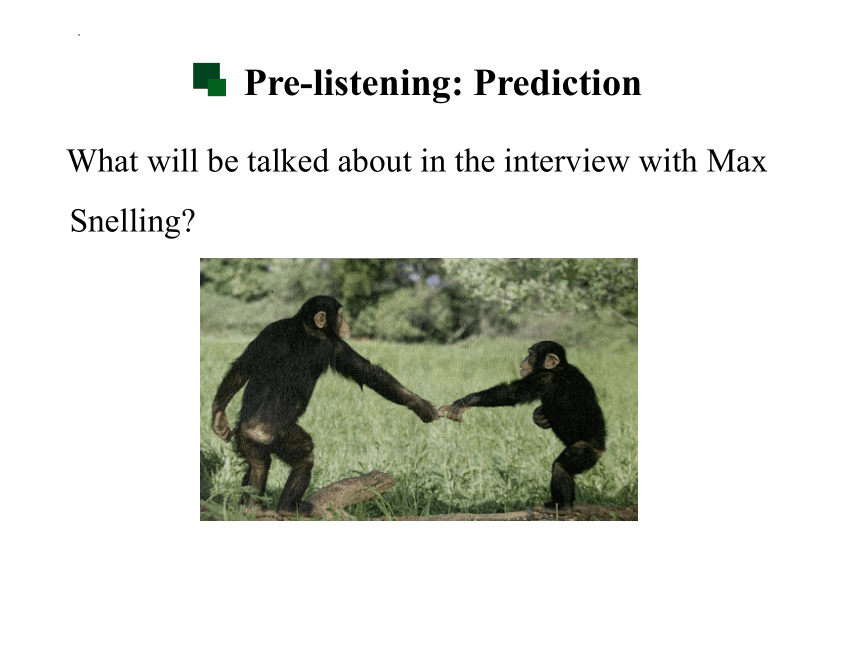
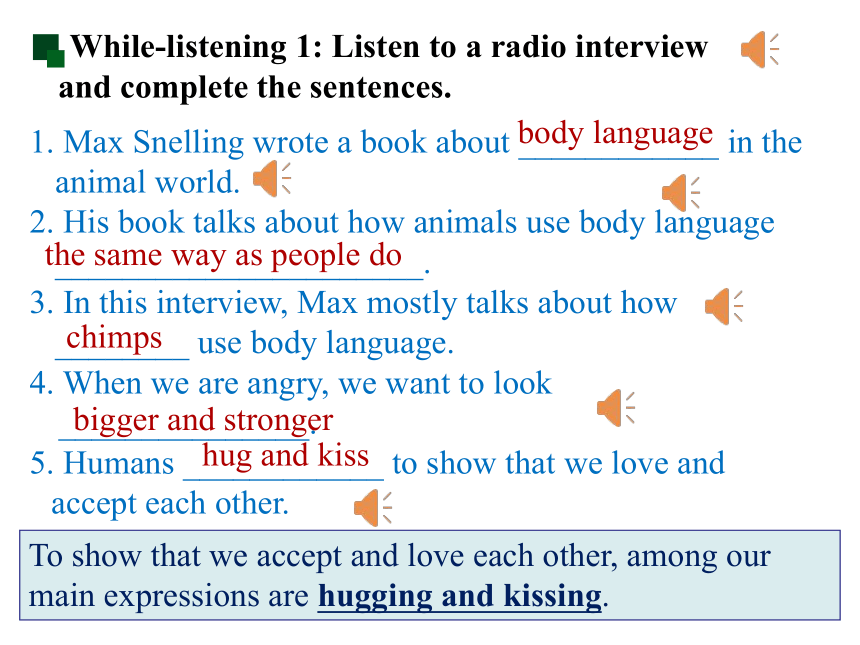

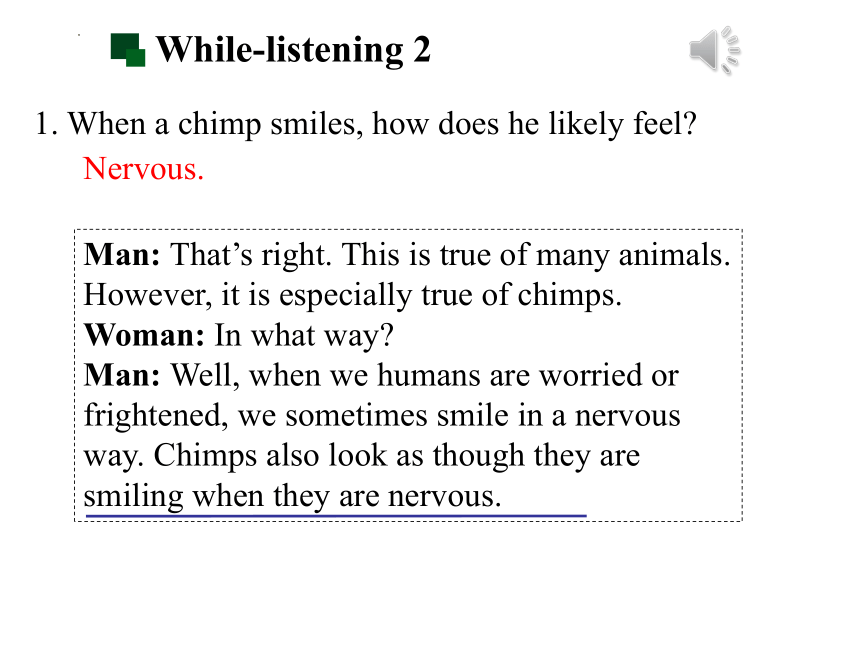
文档简介
(共13张PPT)
Unit 4 Body Language
Listening and Speaking
(Workbook P84)
In this lesson, we will
1. learn information about animal body language;
2. give a short presentation on it.
Learning objectives
Lead-in: Speaking
What is the function of body language
— express our thoughts and feelings in our interactions with others.
— help us learn about what others are thinking.
What do cats’ body languages mean in the pictures
tail up, crook at the end
happy/ confident
tail straight up
thrilled/ excited
tail parallel to the ground
on guard
(cautious)
tail down under the body
extremely scared
bigger tail and body, U shape
in fear
(trying to look stronger)
What will be talked about in the interview with Max Snelling
Pre-listening: Prediction
1. Max Snelling wrote a book about ____________ in the animal world.
2. His book talks about how animals use body language ______________________.
3. In this interview, Max mostly talks about how ________ use body language.
4. When we are angry, we want to look _______________.
5. Humans ____________ to show that we love and accept each other.
body language
the same way as people do
chimps
While-listening 1: Listen to a radio interview and complete the sentences.
bigger and stronger
hug and kiss
To show that we accept and love each other, among our main expressions are hugging and kissing.
1. When a chimp smiles, how does he likely feel
2. Why does Max think a chimp smiles when faced with an enemy
3. How are humans and chimps alike in the way they express anger
4. What do chimps do to show they love their babies
5. What does a bigger chimp do to make a smaller chimp feel safe
While-listening 2: Listen to the interview again and answer the questions.
Man: That’s right. This is true of many animals. However, it is especially true of chimps.
Woman: In what way
Man: Well, when we humans are worried or frightened, we sometimes smile in a nervous way. Chimps also look as though they are smiling when they are nervous.
While-listening 2
1. When a chimp smiles, how does he likely feel
Nervous.
Man: ...Chimps also look as though they are smiling when they are nervous.
Woman: Why is that
Man: Perhaps they are trying to look friendly so an enemy will not hurt them. Now, what do we often do when we are angry
While-listening 2
2. Why does Max think a chimp smiles when faced with an enemy
Perhaps they are trying to look friendly so the enemy will not hurt them.
Man: Now, what do we often do when we are angry
Woman: We stand tall and put our hands on our sides. Sometimes we shout.
Man: Exactly. We want to look bigger and stronger. Chimps do the same thing — they stand up, move their arms around, throw things about, and make noise.
While-listening 2
3. How are humans and chimps alike in the way they express anger
We stand tall and make noise.
Woman: What about in family relationships
Man: That’s very interesting. Both chimp and human mothers hold their babies and kiss them. A similar thing is true for adults. To show that we accept and love each other, among our main expressions are hugging and kissing.
While-listening 2
4. What do chimps do to show they love their babies
They hold their babies and kiss them.
Man: ... When a stronger chimp frightens a smaller chimp, the smaller chimp will hold his head low. The bigger one will then touch him or kiss him to make him feel safe.
Woman: So chimps are just like people!
Man: Or, we’re just like chimps.
While-listening 2
5. What does a bigger chimp do to make a smaller chimp feel safe
The bigger chimp will touch or kiss the smaller chimp to make it feel safe.
Dogs use sounds, body movements, and their tails to communicate. When a dog is happy, its ears will stand up and its eyes will be wide open. The dog will start barking, moving its tail, and running around in circles or jumping up and down to show you that it wants to play.
Post-listening: body language of dogs
A dog that is afraid will lie on its back and close its eyes. The dog may show its teeth and lower its body so that it is close to the ground. The dog may also shake, and it will put its tail between its legs.
When a dog is angry, its main body language is showing its teeth and growling ([ɡra l]低沉吼叫). The dog will try making itself look as big as possible. The tail will stand straight out from the body.
Beginning: Animals use body languages to express their feelings just like us.
Body:
When/If __(cats/dogs/chimps...) are___(angry...), they’ll___.
If they___ , it means that____.
Once they get____, it’s likely for them to____.
_____ that are ____ will/ tend to_______.
End: All in all, it’s _______ to learn
animal body languages, which help us
___________
Group work: Discuss how animals use body languages to show feelings (fear/ joy/ anger...) and give a presentation.
Post-listening: Speaking
https://www./cats/bringing-a-cat-home/how-to-read-cats-body-language/
https://mp.weixin./s/suvElr4-jONFm6CTYMQ8Vw
Homework
Visit the websites below to learn pets’ body language.
Find more information on animal body language online.
Unit 4 Body Language
Listening and Speaking
(Workbook P84)
In this lesson, we will
1. learn information about animal body language;
2. give a short presentation on it.
Learning objectives
Lead-in: Speaking
What is the function of body language
— express our thoughts and feelings in our interactions with others.
— help us learn about what others are thinking.
What do cats’ body languages mean in the pictures
tail up, crook at the end
happy/ confident
tail straight up
thrilled/ excited
tail parallel to the ground
on guard
(cautious)
tail down under the body
extremely scared
bigger tail and body, U shape
in fear
(trying to look stronger)
What will be talked about in the interview with Max Snelling
Pre-listening: Prediction
1. Max Snelling wrote a book about ____________ in the animal world.
2. His book talks about how animals use body language ______________________.
3. In this interview, Max mostly talks about how ________ use body language.
4. When we are angry, we want to look _______________.
5. Humans ____________ to show that we love and accept each other.
body language
the same way as people do
chimps
While-listening 1: Listen to a radio interview and complete the sentences.
bigger and stronger
hug and kiss
To show that we accept and love each other, among our main expressions are hugging and kissing.
1. When a chimp smiles, how does he likely feel
2. Why does Max think a chimp smiles when faced with an enemy
3. How are humans and chimps alike in the way they express anger
4. What do chimps do to show they love their babies
5. What does a bigger chimp do to make a smaller chimp feel safe
While-listening 2: Listen to the interview again and answer the questions.
Man: That’s right. This is true of many animals. However, it is especially true of chimps.
Woman: In what way
Man: Well, when we humans are worried or frightened, we sometimes smile in a nervous way. Chimps also look as though they are smiling when they are nervous.
While-listening 2
1. When a chimp smiles, how does he likely feel
Nervous.
Man: ...Chimps also look as though they are smiling when they are nervous.
Woman: Why is that
Man: Perhaps they are trying to look friendly so an enemy will not hurt them. Now, what do we often do when we are angry
While-listening 2
2. Why does Max think a chimp smiles when faced with an enemy
Perhaps they are trying to look friendly so the enemy will not hurt them.
Man: Now, what do we often do when we are angry
Woman: We stand tall and put our hands on our sides. Sometimes we shout.
Man: Exactly. We want to look bigger and stronger. Chimps do the same thing — they stand up, move their arms around, throw things about, and make noise.
While-listening 2
3. How are humans and chimps alike in the way they express anger
We stand tall and make noise.
Woman: What about in family relationships
Man: That’s very interesting. Both chimp and human mothers hold their babies and kiss them. A similar thing is true for adults. To show that we accept and love each other, among our main expressions are hugging and kissing.
While-listening 2
4. What do chimps do to show they love their babies
They hold their babies and kiss them.
Man: ... When a stronger chimp frightens a smaller chimp, the smaller chimp will hold his head low. The bigger one will then touch him or kiss him to make him feel safe.
Woman: So chimps are just like people!
Man: Or, we’re just like chimps.
While-listening 2
5. What does a bigger chimp do to make a smaller chimp feel safe
The bigger chimp will touch or kiss the smaller chimp to make it feel safe.
Dogs use sounds, body movements, and their tails to communicate. When a dog is happy, its ears will stand up and its eyes will be wide open. The dog will start barking, moving its tail, and running around in circles or jumping up and down to show you that it wants to play.
Post-listening: body language of dogs
A dog that is afraid will lie on its back and close its eyes. The dog may show its teeth and lower its body so that it is close to the ground. The dog may also shake, and it will put its tail between its legs.
When a dog is angry, its main body language is showing its teeth and growling ([ɡra l]低沉吼叫). The dog will try making itself look as big as possible. The tail will stand straight out from the body.
Beginning: Animals use body languages to express their feelings just like us.
Body:
When/If __(cats/dogs/chimps...) are___(angry...), they’ll___.
If they___ , it means that____.
Once they get____, it’s likely for them to____.
_____ that are ____ will/ tend to_______.
End: All in all, it’s _______ to learn
animal body languages, which help us
___________
Group work: Discuss how animals use body languages to show feelings (fear/ joy/ anger...) and give a presentation.
Post-listening: Speaking
https://www./cats/bringing-a-cat-home/how-to-read-cats-body-language/
https://mp.weixin./s/suvElr4-jONFm6CTYMQ8Vw
Homework
Visit the websites below to learn pets’ body language.
Find more information on animal body language online.
